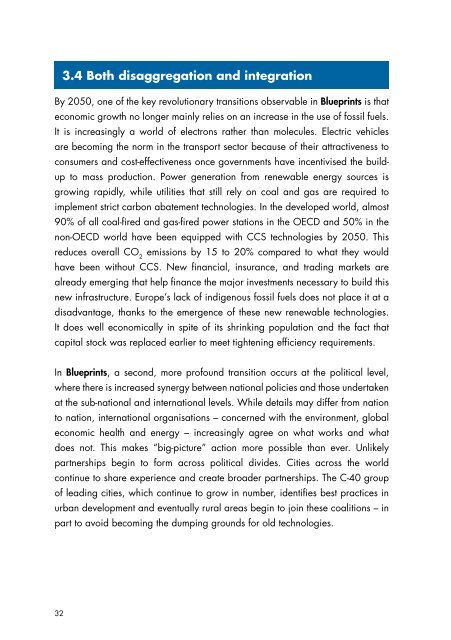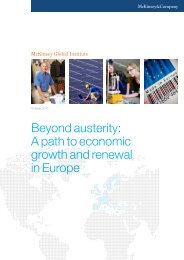Shell energy scenarios to 2050 - Manicore
Shell energy scenarios to 2050 - Manicore
Shell energy scenarios to 2050 - Manicore
You also want an ePaper? Increase the reach of your titles
YUMPU automatically turns print PDFs into web optimized ePapers that Google loves.
3.4 Both disaggregation and integrationBy <strong>2050</strong>, one of the key revolutionary transitions observable in Blueprints is thateconomic growth no longer mainly relies on an increase in the use of fossil fuels.It is increasingly a world of electrons rather than molecules. Electric vehiclesare becoming the norm in the transport sec<strong>to</strong>r because of their attractiveness <strong>to</strong>consumers and cost-effectiveness once governments have incentivised the buildup<strong>to</strong> mass production. Power generation from renewable <strong>energy</strong> sources isgrowing rapidly, while utilities that still rely on coal and gas are required <strong>to</strong>implement strict carbon abatement technologies. In the developed world, almost90% of all coal-fired and gas-fired power stations in the OECD and 50% in thenon-OECD world have been equipped with CCS technologies by <strong>2050</strong>. Thisreduces overall CO 2emissions by 15 <strong>to</strong> 20% compared <strong>to</strong> what they wouldhave been without CCS. New financial, insurance, and trading markets arealready emerging that help finance the major investments necessary <strong>to</strong> build thisnew infrastructure. Europe’s lack of indigenous fossil fuels does not place it at adisadvantage, thanks <strong>to</strong> the emergence of these new renewable technologies.It does well economically in spite of its shrinking population and the fact thatcapital s<strong>to</strong>ck was replaced earlier <strong>to</strong> meet tightening efficiency requirements.In Blueprints, a second, more profound transition occurs at the political level,where there is increased synergy between national policies and those undertakenat the sub-national and international levels. While details may differ from nation<strong>to</strong> nation, international organisations – concerned with the environment, globaleconomic health and <strong>energy</strong> – increasingly agree on what works and whatdoes not. This makes “big-picture” action more possible than ever. Unlikelypartnerships begin <strong>to</strong> form across political divides. Cities across the worldcontinue <strong>to</strong> share experience and create broader partnerships. The C-40 groupof leading cities, which continue <strong>to</strong> grow in number, identifies best practices inurban development and eventually rural areas begin <strong>to</strong> join these coalitions – inpart <strong>to</strong> avoid becoming the dumping grounds for old technologies.32



